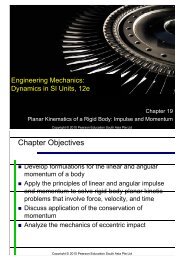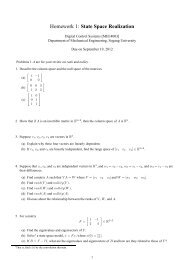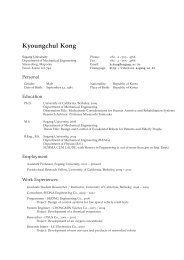Digital Control Systems [MEE 4003] - Kckong.info
Digital Control Systems [MEE 4003] - Kckong.info
Digital Control Systems [MEE 4003] - Kckong.info
Create successful ePaper yourself
Turn your PDF publications into a flip-book with our unique Google optimized e-Paper software.
2.1. STATE SPACE REALIZATION OF DYNAMIC SYSTEMS 13<br />
c<br />
x 2<br />
k<br />
0 0<br />
x 1<br />
u 1<br />
Figure 2.2: An equivalent model of the creeping phenomenon.<br />
• The springk 2 is placed betweenm 1 andm 2 . Thus,K 12 = K 21 = −k 2 . Between<br />
m 2 and m 3 , the spring k 3 is placed, i.e., K 23 = K 32 = −k 3 . Similarly, K 13 =<br />
K 31 = −k 4 .<br />
⎡<br />
⎣<br />
Finally, the mathematical model of the three mass-spring-damper system is<br />
⎤ ⎡ ⎤ ⎡<br />
⎤<br />
m 1 0 0 c 1 +c 2 −c 2 0 k 1 +k 2 +k 4 −k 2 −k 4<br />
0 m 2 0 ⎦ẍ+ ⎣ −c 2 c 2 0 ⎦ẋ+ ⎣ −k 2 k 2 +k 3 −k 3<br />
⎦x<br />
0 0 m 3 0 0 0 −k 4 −k 3 k 3 +k 4<br />
(d) The modeling of creep phenomenon of materials is introduced in this example. In<br />
materials science, creep is the tendency of a solid material to slowly move or deform<br />
permanently under the influence of stresses. In order to find the mathematical model<br />
of the creep phenomenon, an equivalent model is introduced with fictitious masses<br />
(m = 0) as in Fig. 2.2.<br />
wherex =<br />
The mathematical model of the equivalent model is<br />
[ ] [ ] [<br />
0 0 0 0<br />
ẍ+ ẋ+<br />
0 0 0 c<br />
] [ ]<br />
∈ R<br />
x 2 u1<br />
and u = ∈ R<br />
2 0<br />
2 .<br />
[<br />
x1<br />
k −k<br />
−k k<br />
]<br />
x = u<br />
(e) In the figure, x is the position from the top of the bar, andv is the distance from the<br />
vertical line to the center line of the deflected bar. The internal moment in the bar, M,<br />
is related to its deflected shape, v, by<br />
EI d2 v<br />
dx 2 = M<br />
The internal moment,M, is determined by the applied force, P , and the distance from<br />
the vertical line, v (i.e., M = −Pv). Therefore, the bar under a compressive load is<br />
modeled by<br />
EI d2 v<br />
dx 2 +Pv = 0<br />
<strong>Digital</strong> <strong>Control</strong> <strong>Systems</strong>, Sogang University<br />
Kyoungchul Kong


![Digital Control Systems [MEE 4003] - Kckong.info](https://img.yumpu.com/32606446/14/500x640/digital-control-systems-mee-4003-kckonginfo.jpg)
![Digital Control Systems [MEE 4003] - Kckong.info](https://img.yumpu.com/40221932/1/184x260/digital-control-systems-mee-4003-kckonginfo.jpg?quality=85)


